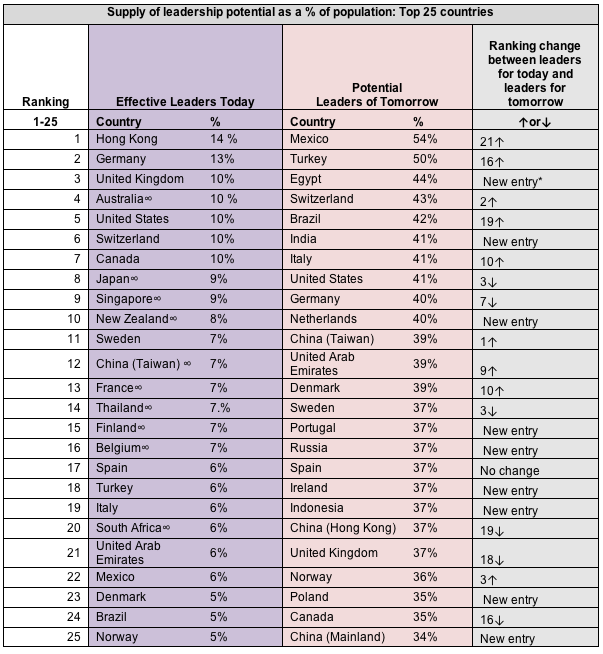- UK currently tops talent table but falls out of top 20 for future leaders
- Emerging markets set to shine with huge untapped leadership potential
SHL today launches its first Global Leadership study, providing a worldwide view of leadership potential. The study identifies the top 25[1] countries based on the analysis of over a million people from SHL’s global Talent Analytics(TM) database. Hong Kong, Germany and the UK have more effective leaders today than any other country in the study whilst Denmark, Brazil and Norway have the lowest supply.
The landscape of leadership potential changes significantly when analysing the supply of leadership talent for tomorrow*. Mexico, Turkey and Egypt have the greatest source of potential future leaders. In contrast, the UK drops 18 places to fall out of the top 20 and Hong Kong falls from poll position to 20th whilst Mexico and Brazil jump 19 and 21 places respectively, with Mexico topping the table.
“Despite having a strong supply of leaders for today, the UK has a leadership time bomb on its hands if it doesn’t invest in learning and development to cultivate its potential leaders and remain competitive,” said Paul Levett, chief product officer, at SHL. “Rising education standards and a culture of entrepreneurialism are some of the many environmental factors that are driving emerging economies such as Brazil, India, Mexico and Turkey up the rankings for future leadership potential. These nations have a huge growth opportunity if they can identify, nurture and develop this potential.”
“Companies need to build greater intelligence about the leadership talent within their organisations and be aware of opportunities outside their domestic markets. Understanding the supply of leadership where organisations operate is crucial for adapting leadership development and talent mobility programmes so that companies remain competitive in the global economy.”
SHL recommends a five pronged approach to cultivating leadership success across an organisation:
- Firstly, identify the behaviours and skills which make a successful leader in your organisation
- Have a full picture of the leadership potential across your organisation and don’t restrict that view to only those you think are high potential
- Using scientific data, benchmark your people against competitor talent and identify leadership shortages to avoid succession risk
- Focus on development interventions including where to spend learning and development budgets and apply this across the business
- Take a global view of where your leadership talent is located and be prepared to use creative strategies to source talent across borders to fill leadership gaps
Top 25 countries with leadership potential today and tomorrow

*New entry – those countries not ranked in the top 25 leaders today but listed in the top 25 for leadership potential tomorrow
∞Indicates those counties ranked in the top 25 leaders today but not listed in the top 25 for leadership t potential tomorrow
Additional findings from the study:
- Globally, only 1 in 15 (6.7%), managers and professionals qualify as effective leaders today. 1 in 3 managers and professionals have the next tier of potential leaders of tomorrow but for this level of people the journey to realise that potential is longer and needs targeted investment. The value of investing in these people is substantial because there are six times as many managers and professionals with this level of potential than effective leaders of today
- In China (Taiwan), Germany, Sweden, Switzerland and United States, the supply of effective leaders for today and potential leaders of tomorrow is stronger than the average global supply. While competing for leadership talent remains a challenge in these geographies, the odds of finding effective leaders today are significantly higher at 1 in 10 vs. the global average of 1 in 15



